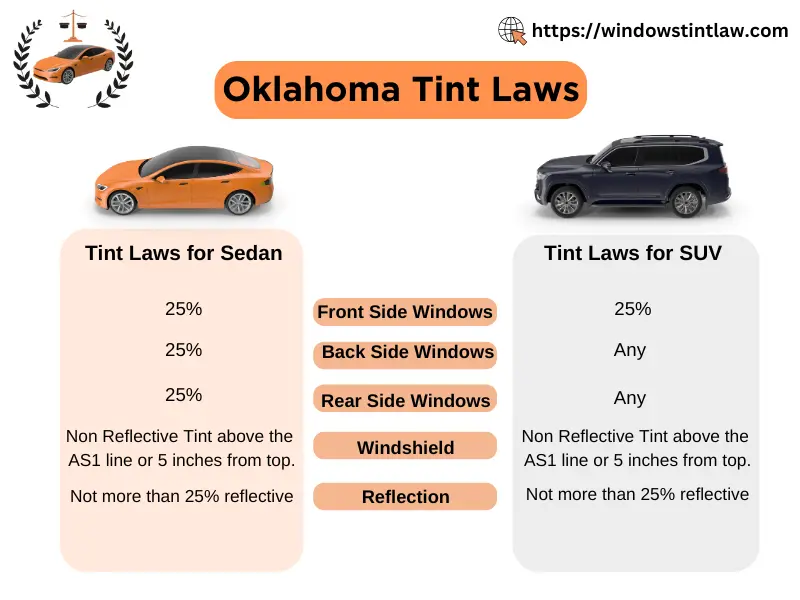Oklahoma tint laws were legislated in 2005 and became effective from September 1,2005.
We have covered complete details about the Oklahoma Tinting rules for Sedan & SUV vehicles. You’ll get clear guide for the legal tint darkness, Allowed tint reflection limits and some other rules and regulations.
It is recommended for vehicle owners and drivers to follow the Tint Darkness limits in terms of Visible Light Transmission percentage and Permissible Tint reflection limits. Drivers must install the suitable tinting material type to ensure it complies with tint laws.
Overview of Oklahoma Tint Laws
The below image outlines the legal tint darkness and tint reflection limits for Cars and SUV or Trucks. The below parentages refers to the allowed percentage of visible light, which must pass through vehicle windows with tinted materials.

Darkest Legal Tint in Oklahoma
The darkest legal tint shades for Sedan and SUV’s in Oklahoma are mentioned as below:
Tint Darkness For Sedan
| State | Front Side Windows | Back Side Windows | Rear Window | Windshield | Tint Reflection | Other Rules |
| Oklahoma | 25% | 25% | 25% | Non-reflective tint above the AS-1 line or 5 inches from top. | Not more than 25% reflective. | Dual Side Mirrors are required if rear window is tinted. |
Tint Darkness For SUV, Trucks or Vans
| State | Front Side Windows | Back Side Windows | Rear Window | Windshield | Tint Reflection | Other Rules |
| Oklahoma | 25% | Any | Any | Non-reflective tint above the AS1 line or 5 inches from top. | Not more than 25% reflective. | Dual Side Mirrors are required if rear window is tinted. |
Window Tint Reflection
All motor vehicles with tinted materials applied to windows, must have solar reflectance of not more than 25%. The same rule is applicable for Cars and Trucks registered in Oklahoma.
It is important to Choose the window tint types wisely, it should be in accordance with Oklahoma Tint Laws.
Reflective tint films produces glare due to sunlight, which causes inconvenience for other drivers. That’s why State laws restricts window films should have a limited solar reflectance.
Other Rules and Regulations
Besides the Tint darkness and reflection limits, there are some other rules to be followed:
- Dual Side Mirrors: Dual side mirrors are mandatory if the rear window is tinted.
- Tint Color Restriction: Colored tint materials are not allowed.
- Certificates: Window Film Manufacturers required to get certificate for the tinting materials they sell in state.
- Stickers: Stickers to identify legal tint is not required to display on the window glass.
Medical Exemption
According to Oklahoma Motor Vehicle Statutes for Using Glass coated materials on windshields and windows, Any person with certain medical conditions can apply for medical exemption or tint waiver. The application for medical exemption shall be submitted to The Commissioner for Public Safety and must be certified by licensed physician. The attested application must states that the applicant need to get shielded from direct sunrays.
After getting the Medical waiver, Any person can alter the color or reduce the light transmitted through the side or rear windows of a vehicle in accordance with the waiver issued by the Commissioner.
Penalties for Violating Tint Laws
If any individual caught by police due to illegal tint, the first ticket is usually a Fix-it ticket with a warning to remove the tint. The driver must remove it or change the tint shade to meet the requirements of Oklahoma Tinting Laws. Police or law enforcement agencies use Tint Meter or Window Tint reader to identify the illegal tint.
For second time, tint tickets can cost $100 or more depending on type of violation you made. For subsequent offenses or failure to comply with tinting rules can lead to serious legal consequences and heavy fines.
Notwithstanding with above, Windows tinting provide benefits but adherence with state laws is mandatory and must be followed by all citizens to avoid penalties.
